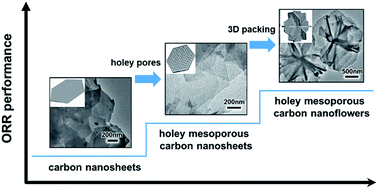当前位置:
X-MOL 学术
›
J. Mater. Chem. A
›
论文详情
Our official English website, www.x-mol.net, welcomes your
feedback! (Note: you will need to create a separate account there.)
Nitrogen-doped carbon nanosheets and nanoflowers with holey mesopores for efficient oxygen reduction catalysis†
Journal of Materials Chemistry A ( IF 10.7 ) Pub Date : 2018-04-30 00:00:00 , DOI: 10.1039/c8ta02319k Hao Tian 1, 2, 3, 4, 5 , Nan Wang 1, 2, 3, 4, 5 , Fugui Xu 1, 2, 3, 4, 5 , Pengfei Zhang 1, 2, 3, 4, 5 , Dan Hou 1, 2, 3, 4, 5 , Yiyong Mai 1, 2, 3, 4, 5 , Xinliang Feng 6, 7, 8, 9
Journal of Materials Chemistry A ( IF 10.7 ) Pub Date : 2018-04-30 00:00:00 , DOI: 10.1039/c8ta02319k Hao Tian 1, 2, 3, 4, 5 , Nan Wang 1, 2, 3, 4, 5 , Fugui Xu 1, 2, 3, 4, 5 , Pengfei Zhang 1, 2, 3, 4, 5 , Dan Hou 1, 2, 3, 4, 5 , Yiyong Mai 1, 2, 3, 4, 5 , Xinliang Feng 6, 7, 8, 9
Affiliation

|
Efficient structure optimization is one of the key factors for improving the oxygen reduction reaction (ORR) catalytic performance of carbon materials. This paper describes a dual-template method for fabrication of new carbon materials as ORR catalysts, including N-doped carbon nanosheets and nanoflowers with holey mesopores, by employing a polystyrene-b-poly(ethylene oxide) block copolymer as the pore-forming agent, layered double hydroxide (LDH) nanosheets or nanoflowers as the sacrificial morphology-directing template, and m-phenylenediamine as the carbon precursor. The resultant carbon materials possess a honeycomb-like mesoporous structure with similar nitrogen contents of ∼4 wt%, an average pore size of ∼14 nm and a specific surface area of ∼260 m2 g−1. Due to the presence of the holey mesopores that facilitate mass transfer and may shorten the diffusion distance of O2 molecules to the active sites, the nanosheets and the nanoflowers exhibit excellent electrocatalytic performance when serving as metal-free ORR catalysts in basic media with high half-wave-potentials (+0.80 V) and limiting current densities (5.5 mA cm−2) which surpass those of many reported carbon-based materials with much higher surface areas but without holey pores. Moreover, the porous nanoflowers show better electrocatalytic activity than that of the nanosheets, profiting from their 3D structure that can prevent the blockage of partial holey pores caused by the preferential layer-by-layer stacking of the nanosheets.
中文翻译:

氮掺杂的碳纳米片和带有多孔中孔的纳米花,可有效催化氧还原†
有效的结构优化是提高碳材料的氧还原反应(ORR)催化性能的关键因素之一。本文描述了一种双模板方法,该方法通过使用聚苯乙烯-b-聚环氧乙烷嵌段共聚物作为成孔剂来制造用作ORR催化剂的新型碳材料,包括N掺杂的碳纳米片和带孔的中孔纳米花。,层状双氢氧化物(LDH)纳米片或纳米花作为牺牲形态导向模板,米苯二胺作为碳前体。所得的碳材料具有类似蜂窝状的中孔结构,其中氮含量相似,约为4 wt%,平均孔径约为14 nm,比表面积约为260 m 2 g-1。由于存在有孔的介孔,有利于质量转移,并可能缩短O 2分子到活性位点的扩散距离,因此当在高半数碱性介质中用作无金属的ORR催化剂时,纳米片和纳米花表现出出色的电催化性能。 -波电势(+0.80 V)和极限电流密度(5.5 mA cm -2)超过了许多报道的碳基材料的表面积和表面积,但没有孔洞,超过了许多报道的碳基材料。此外,多孔纳米花显示出比纳米片更好的电催化活性,得益于其3D结构,该结构可以防止由于纳米片的优先逐层堆叠而引起的部分孔的阻塞。
更新日期:2018-04-30
中文翻译:

氮掺杂的碳纳米片和带有多孔中孔的纳米花,可有效催化氧还原†
有效的结构优化是提高碳材料的氧还原反应(ORR)催化性能的关键因素之一。本文描述了一种双模板方法,该方法通过使用聚苯乙烯-b-聚环氧乙烷嵌段共聚物作为成孔剂来制造用作ORR催化剂的新型碳材料,包括N掺杂的碳纳米片和带孔的中孔纳米花。,层状双氢氧化物(LDH)纳米片或纳米花作为牺牲形态导向模板,米苯二胺作为碳前体。所得的碳材料具有类似蜂窝状的中孔结构,其中氮含量相似,约为4 wt%,平均孔径约为14 nm,比表面积约为260 m 2 g-1。由于存在有孔的介孔,有利于质量转移,并可能缩短O 2分子到活性位点的扩散距离,因此当在高半数碱性介质中用作无金属的ORR催化剂时,纳米片和纳米花表现出出色的电催化性能。 -波电势(+0.80 V)和极限电流密度(5.5 mA cm -2)超过了许多报道的碳基材料的表面积和表面积,但没有孔洞,超过了许多报道的碳基材料。此外,多孔纳米花显示出比纳米片更好的电催化活性,得益于其3D结构,该结构可以防止由于纳米片的优先逐层堆叠而引起的部分孔的阻塞。











































 京公网安备 11010802027423号
京公网安备 11010802027423号